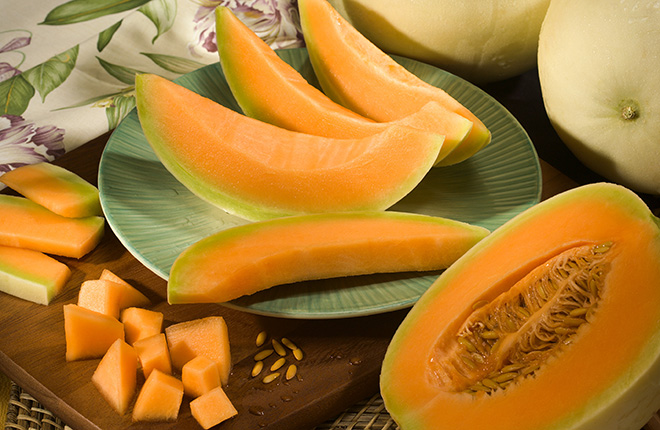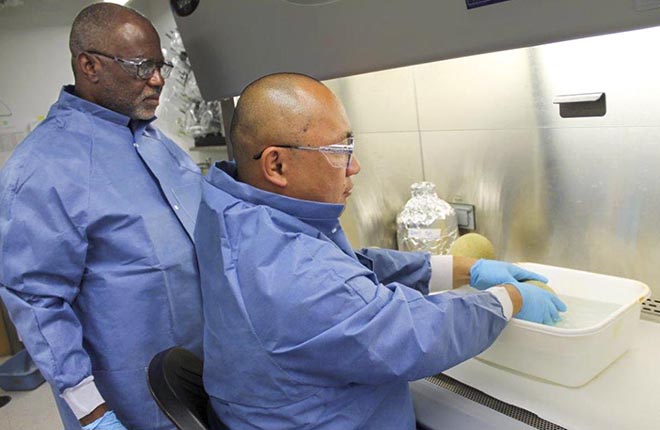New Wash for Sanitizing Fresh Produce
An Agricultural Research Service scientist in Pennsylvania has developed a sanitizing wash formulated with natural compounds that could reduce the number of foodborne illnesses caused each year by Escherichia coli, Salmonella, and Listeria on fresh-cut produce.
Food processors sometimes use chlorinated water or hydrogen peroxide-based washes to sanitize produce, but they are not always effective. Washing produce at home in water before slicing it also helps, but bacteria can persist in cut-up pieces. Each year about 1 in 6 Americans (or 48 million people) get sick; 128,000 are hospitalized; and 3,000 die of foodborne diseases, according to the U.S. Centers for Disease Control and Prevention.
“We know there is a strong demand among food processors, restaurants, outlets that market fresh produce, and the general public for a safe, simple-to-use product that reduces the risk of fresh-cut fruits and vegetables being contaminated with harmful bacteria,” says Dike Ukuku, a food technologist at the ARS Food Safety and Intervention Technologies Unit in Wyndmoor.
Ukuku has discovered that a nisin-EDTA base solution works better than water, chlorinated water, or hydrogen peroxide at ridding cantaloupes, honeydew melons, and other produce of surface bacteria that migrate onto cut-up pieces. Nisin is produced by lactic acid bacteria, a strain of bacteria that is a standard ingredient in making buttermilk, cheese, and yogurt. It is classified as Generally Recognized as Safe (GRAS) by the U.S. Food and Drug Administration, so it would face no regulatory hurdles.
Ukuku has been working with nisin since the early 1990s, but he only recently found that combining it with EDTA—a common preservative used in processed foods and soft drinks—and with certain GRAS organic acids produces a wash that curbs both Gram-positive bacteria (such as Listeria) and Gram-negative ones (such as Salmonella and E. coli).
The wash, which Ukuku calls “Lovit,” could be formulated into a spray and used by food processors, supermarkets, restaurants, and anyone else concerned about food safety. Along with reducing bacteria on watermelon, cantaloupe, honeydew, tomato, cucumber, lettuce, and spinach, Lovit also slows browning on fresh-cut apples and enhances freshness in pears, Ukuku says. He has published a study highlighting its effectiveness, has filed a patent application, and has a commercial partner interested in marketing it.
In the study, Ukuku inoculated the rinds of cantaloupes with E. coli, Salmonella, and Listeria and washed them for 5 minutes in either his treatment, hydrogen peroxide, or chlorinated water. He allowed them to dry, cut them up, and stored some pieces in plastic tubs at room temperature (68 ˚F) for 24 hours and others at chilled temperatures of either 41 ˚F or 50 ˚F for 15 days.
The results showed Lovit to be the most effective treatment of the three, and it reduced pathogen levels to below detection levels required by food safety standards.
The study was published in the Journal of Food Protection in June 2015.—By Dennis O’Brien, Agricultural Research Service Information Staff.
“New Wash for Sanitizing Fresh Produce” was published in the September 2015 issue of AgResearch Magazine.
Key Facts
- New wash sanitizes produce better than water and commercial treatments.
- Ingredients are generally recognized as safe for use in foods.
- The produce wash offers an alternative for anyone concerned about food safety and food outbreaks.
- A commercial partner is interested in marketing the new wash.
Full Story








